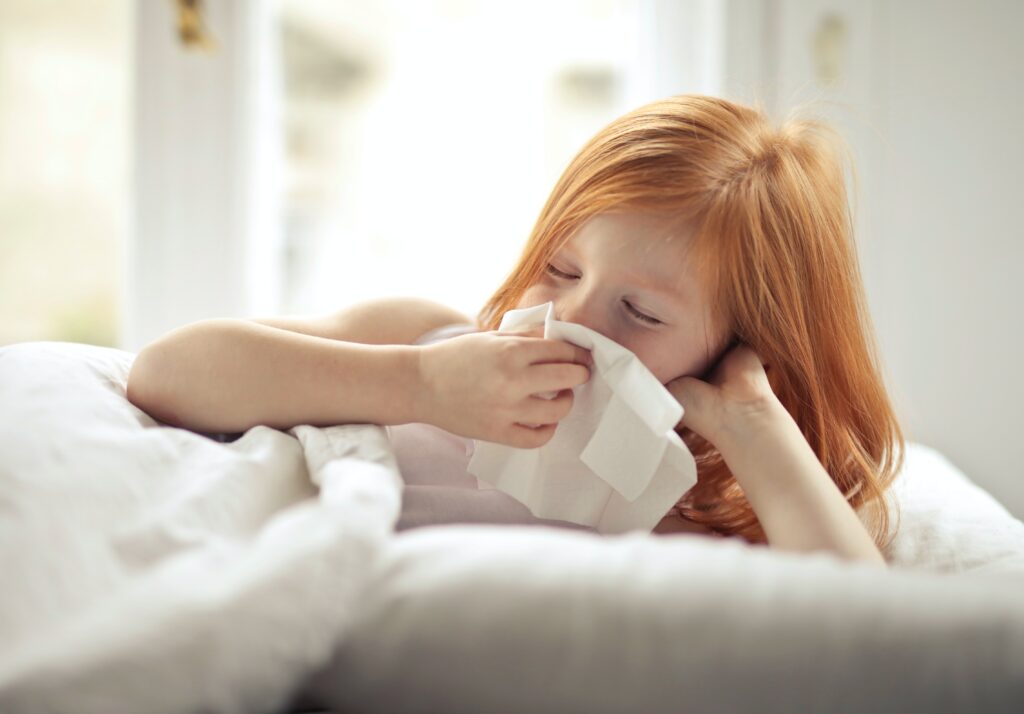Photo by Andrea Piacquadio via pexels.Are you looking for a Thanksgiving health story? Consider adding the brewing “tripledemic” of pathogens to your coverage. Respiratory syncytial virus (RSV), influenza and SARS-CoV-2, the virus that causes COVID-19, are overwhelming hospitals, and some health care experts are urging families to bring back some of the pandemic’s mitigation measures during the holiday.
In some parts of the country, schools have been forced to close. Parents have had to take time off work to care for sick children, and six large children’s hospitals recently set up tents in their parking lots because they had no more beds inside.
“There is a tripledemic out there… It caught us flat-footed,” William Schaffner, M.D., Vanderbilt University professor of infectious diseases, said during an Infectious Disease Society of American media briefing on Nov. 18.
He urged families, especially those with members 65 and older or those who have underlying conditions, to bring back indoor masking and COVID-19 testing before sitting down at the holiday table. He also said he most wanted to urge older adults to take RSV seriously because new data show it can be as dangerous as the flu.
“There’s over 10 times increase in the number of deaths due to RSV during the season among adults,” Schaffner said. So “dust[masks] off. Bring them back out.”
While colder weather usually ushers in the season of infectious respiratory illnesses, this year they have occurred earlier, in higher numbers and in succession, further stretching already strained hospitals and health care providers.
The number of flu cases has elevated in many parts of the country, with a positivity rate of almost 15%, an indication that it is spreading rapidly, according to the CDC. Since the end of October, there has also been a slight uptick in new hospitalizations for COVID-19, according to the CDC. For sources to help you cover the flu, see our recently updated AHCJ tip sheet on the flu and for COVID-19, see our COVID-19 page with sources.
RSV is a ubiquitous virus associated with causing the common cold. People may get it multiple times in their lifetime, but it can make children and those 65 and older particularly sick. What surprised health officials is the surge in RSV cases, severely sickening children and older adults. At the same time, the flu has begun to surge, and COVID-19 is still sickening thousands of Americans.
“It’s one after the other after the other,” said Tina Tan, M.D., an infectious disease physician at Ann & Robert H. Lurie Children’s Hospital of Chicago. “It really is putting a major strain on hospital systems all across the United States.”
The latest CDC figures show that hospitalizations in October for RSV surpassed figures from October 2021 and usually RSV cases surge in December through February. Unlike the flu and COVID-19, there is no vaccine available to the public, though there might be one available in 2023.
Health providers aren’t sure why exactly all three viruses seem to be so contagious and making people so sick this year, but Schaffner said he think it is “exposure debt” in that masking and social distancing measures over the past two and a half years, reduced the exposure of people’s immune systems to pathogens, slowing the immune system’s recognition of some pathogen threats.
To help you with coverage of RSV, here is a Nov. 4 Q&A on RSV written by AHCJ’s core topic leader on medical studies, Tara Haelle. It provides excellent information for understanding the virus. Here is another helpful Q&A written on Nov. 10 by epidemiologist Katelyn Jetelina, who is now a consultant to the CDC on science communication. And here are media-friendly experts and their contact information, suggested by the Infectious Diseases Society of America.
- Aaron E. Glatt, M.D., M.A.C.P., F.I.D.S.A., F.S.H.E.A., Mount Sinai South Nassau’s chief of infectious diseases and an Icahn School of Medicine professor, (516) 632-3933
- Vadana Madhavan, MD, MPH, FAAP, Mass General Hospital for Children clinical director of pediatric infectious disease, (617) 726-2728
- Jason G. Newland MD, Med Washington University in St. Louis professor of pediatrics and pediatric infectious diseases and vice chair of community health and strategic planning, jgnewland@wustl.edu
- Andrew T. Pavia MD, F.A.A.P., F.A.C.P., F.I.D.S.A., University of Utah professor and chief, Division of Pediatric Infectious Diseases, director, Hospital Epidemiology Program, Primary Children’s Hospital, u0028338@utah.edu
- Tina Q. Tan, M.D., F.A.A.P., F.I.D.S.A., F.P.I.D.S., Ann & Robert H. Lurie Children’s Hospital of Chicago Northwestern University Feinberg School of Medicine and professor of pediatrics, titan@luriechildrens.org










